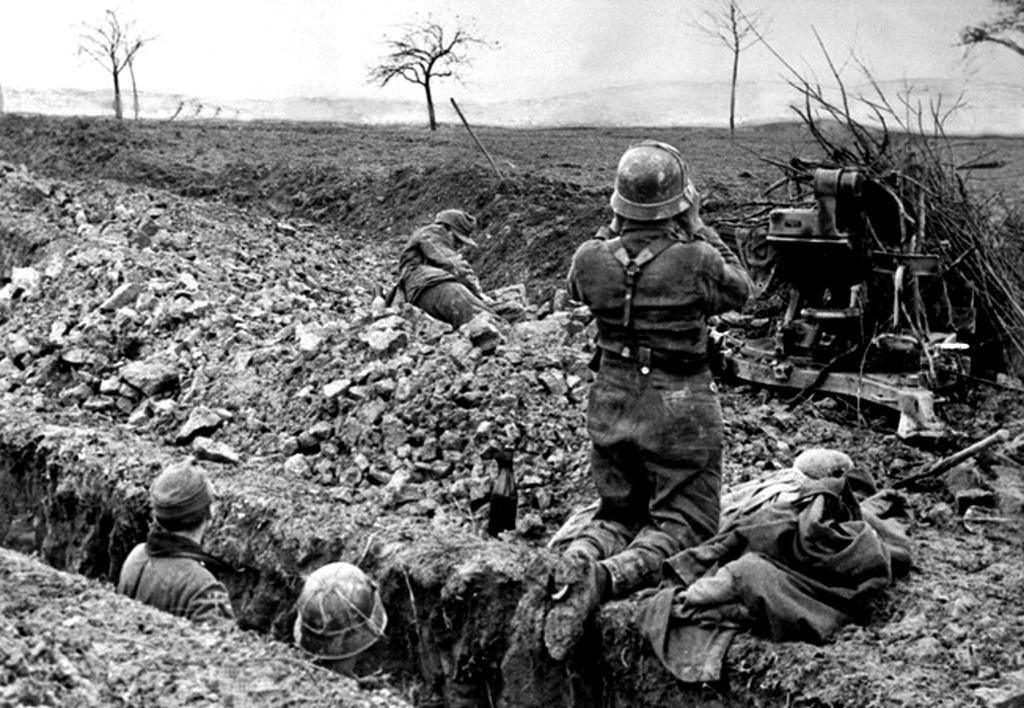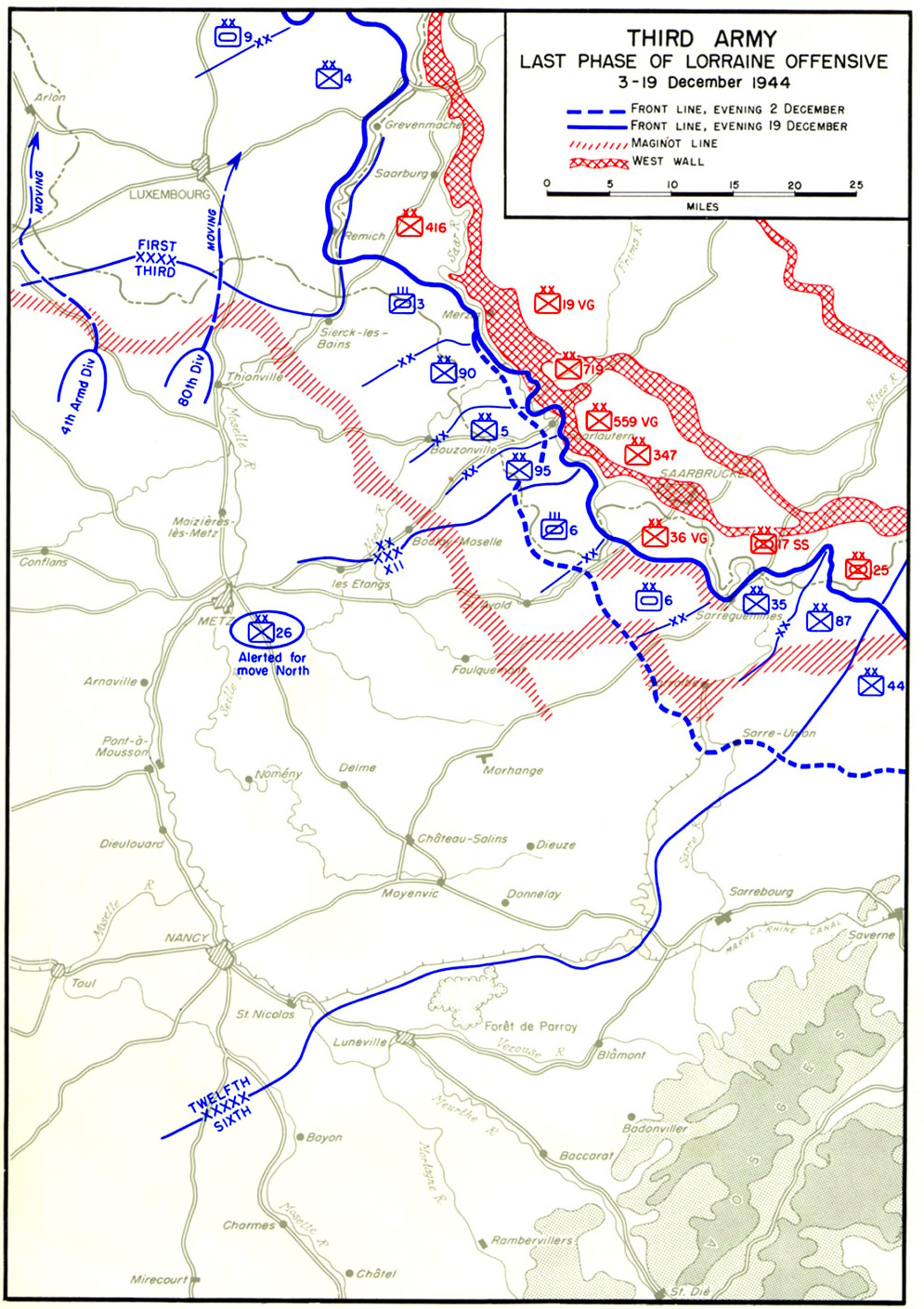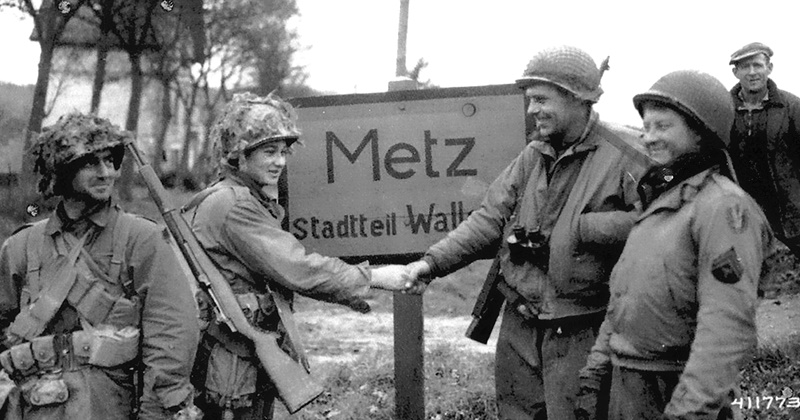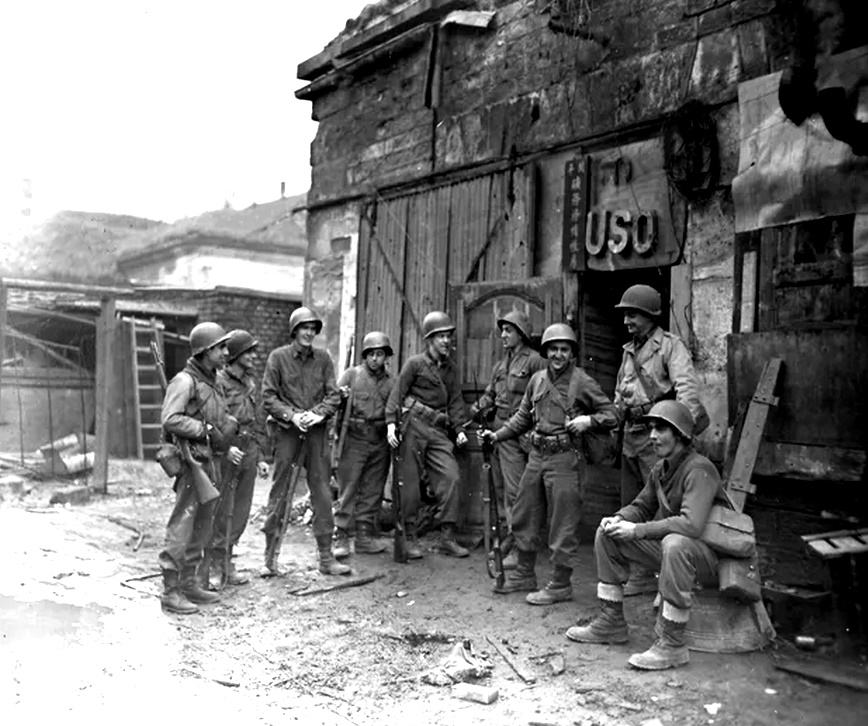Document source: Operations of the 1st Battalion, 379th Infantry Regiment, 95th Infantry Division in Saarlautern, Germany, December 2, 1944, – December 6, 1944. during the Rhineland Campaign, Capt Albert V. Kinslow, Battalion Reconnaissance Officer, 1/379-95-ID
INTRODUCTION
 This archive covers the operation of the 1st Battalion, 379th Infantry Regiment of the 95th US Infantry Division, in the Rhineland Campaign, in the crossing of the Saar River and capture and defense of the bridge at Saarlautern. A short history of the 1st Battalion and a brief summary of preceding events leading up to the crossing of the Saar River and capture of the bridge will aid the reader in a clearer perception of the situation. This operation won acknowledgment from the War Department when Robert P. Patterson, then Undersecretary of War, made the following statement to a press conference: ‘The 95th Division performed with great distinction in taking intact the Saarlautern Bridge‘.
This archive covers the operation of the 1st Battalion, 379th Infantry Regiment of the 95th US Infantry Division, in the Rhineland Campaign, in the crossing of the Saar River and capture and defense of the bridge at Saarlautern. A short history of the 1st Battalion and a brief summary of preceding events leading up to the crossing of the Saar River and capture of the bridge will aid the reader in a clearer perception of the situation. This operation won acknowledgment from the War Department when Robert P. Patterson, then Undersecretary of War, made the following statement to a press conference: ‘The 95th Division performed with great distinction in taking intact the Saarlautern Bridge‘.

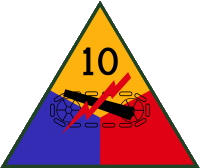 The Battalion saw its first combat on October 18, 1944, when the 379th Infantry relieved the 11th Infantry Regiment of the 5th Infantry Division on the Moselle River bridgehead in the vicinity of Arry, France. The extent of its combat there was principally defensive; there was no offensive action except for a few patrols. The 379th Infantry Regiment was relieved two weeks later by the
The Battalion saw its first combat on October 18, 1944, when the 379th Infantry relieved the 11th Infantry Regiment of the 5th Infantry Division on the Moselle River bridgehead in the vicinity of Arry, France. The extent of its combat there was principally defensive; there was no offensive action except for a few patrols. The 379th Infantry Regiment was relieved two weeks later by the  same elements of the 5th Infantry Division. The 95th Infantry Division then moved north and relieved elements of the 90th Infantry Division and the 10th Armored Division. From this position, the 1st Battalion was soon engaged in one of the most bitter battles of World War II – the fight for Metz, the world’s most fortified city. It was in Metz that the officers and men gained the experience and confidence to make them combat veterans. Casualties were heavy, not so much in number but in the loss of key men – mostly high-ranking noncommissioned officers.
same elements of the 5th Infantry Division. The 95th Infantry Division then moved north and relieved elements of the 90th Infantry Division and the 10th Armored Division. From this position, the 1st Battalion was soon engaged in one of the most bitter battles of World War II – the fight for Metz, the world’s most fortified city. It was in Metz that the officers and men gained the experience and confidence to make them combat veterans. Casualties were heavy, not so much in number but in the loss of key men – mostly high-ranking noncommissioned officers.

 On August 31, 1944, the XX Corps of the Third US Army reached Verdun, France. Though the US 3-A was practically immobilized by the shortage of gasoline, Gen Patton issued an order to Gen Walton H. Walker, CG of the US XX Corps. In brief, it assigned the Corps the mission to above across the Moselle River; capture or encircle Metz; cross the Saar River in the vicinity of Saarburg; continue the attack, crossing the Rhine River at or near Mainz; and attack the final objective of Frankfurt, 160 miles away. This was to prevent the now badly disorganized and fleeing Germans from organizing a capable defense at any of the natural barriers or to use successfully the Maginot Line or the Siegfried Line. This plan was not carried out as scheduled for reasons on which military leaders do not agree, and the final attack on Metz did not begin until November 8, 1944. During the period August 31 to November 8, the Germans occupied the fortifications of Metz and the Siegfried Line.
On August 31, 1944, the XX Corps of the Third US Army reached Verdun, France. Though the US 3-A was practically immobilized by the shortage of gasoline, Gen Patton issued an order to Gen Walton H. Walker, CG of the US XX Corps. In brief, it assigned the Corps the mission to above across the Moselle River; capture or encircle Metz; cross the Saar River in the vicinity of Saarburg; continue the attack, crossing the Rhine River at or near Mainz; and attack the final objective of Frankfurt, 160 miles away. This was to prevent the now badly disorganized and fleeing Germans from organizing a capable defense at any of the natural barriers or to use successfully the Maginot Line or the Siegfried Line. This plan was not carried out as scheduled for reasons on which military leaders do not agree, and the final attack on Metz did not begin until November 8, 1944. During the period August 31 to November 8, the Germans occupied the fortifications of Metz and the Siegfried Line.
Metz was officially captured on November 22, and at this time, the XX Corps changed its original plan to drive towards Saarburg and Merzig and decided to take the most direct route to the Saar River. The change in the original plan was due to the collapse of the enemy after the capture of Metz. The new plan was given in Field Order #13, Headquarters XX Corps, dated November 22, 1944. Parts of the plan pertinent to the 95th Infantry Division were as follows: the 95-ID was to attack northeast to destroy the enemy within its zone, seize crossings of the Saar River between Saarlautern and Pachten, establish a bridgehead in the crossing area, and expand to the north to uncover Rehlingen to facilitate bridging operations of the 90th Infantry Division. Supporting units included the III Corps Artillery, (the III Corps not being operational at this time), elements of the 5th Division Artillery, the 1103rd Engineer Group, the 4th Tank Destroyer Group, and elements of the 119th AAA Battalion.
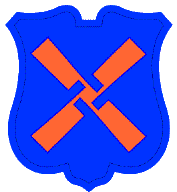 On November 24, the Division was poised on the west bank of the French Nied River, with the 377th Infantry Regiment on the left and the 378th Infantry Regiment on the right. On this date, Col Robert L. Bacon assumed command of the 379-IR, which was containing the five remaining Forts held by the Germans in the Metz Area. The 379-IR was to become Division reserve, upon being relieved by the 2/5-ID. On the morning of November 25, the Division’s attack jumped off at 0730. Resistance was comparatively light, and by night the Division’s front line extended along the Maginot Line defenses. The 2/379-IR was attached to the 377-IR to protect the left flank of the Regiment and Division. The Maginot Line defenses were built for protection from the east, so were of little value to the Germans. During the days of November 26-27, the Division’s attack progressed rapidly with light resistance on the
On November 24, the Division was poised on the west bank of the French Nied River, with the 377th Infantry Regiment on the left and the 378th Infantry Regiment on the right. On this date, Col Robert L. Bacon assumed command of the 379-IR, which was containing the five remaining Forts held by the Germans in the Metz Area. The 379-IR was to become Division reserve, upon being relieved by the 2/5-ID. On the morning of November 25, the Division’s attack jumped off at 0730. Resistance was comparatively light, and by night the Division’s front line extended along the Maginot Line defenses. The 2/379-IR was attached to the 377-IR to protect the left flank of the Regiment and Division. The Maginot Line defenses were built for protection from the east, so were of little value to the Germans. During the days of November 26-27, the Division’s attack progressed rapidly with light resistance on the  left, but with somewhat stronger resistance on the right of the Division Zone. At this time, Gen Manton S. Eddy’s XII Corps, on the Division’s right, changed the direction of its attack from northeast to east, causing a gap to develop on the right flank of the 378-IR. This caused considerable trouble, and various means were used to relieve the situation. First, the Division Reconnaissance Troop was committed on the open flank; then the 3/379-IR was attached to the 378-IR; and later the 10/5-ID was attached to the 95-ID to fill the gap.
left, but with somewhat stronger resistance on the right of the Division Zone. At this time, Gen Manton S. Eddy’s XII Corps, on the Division’s right, changed the direction of its attack from northeast to east, causing a gap to develop on the right flank of the 378-IR. This caused considerable trouble, and various means were used to relieve the situation. First, the Division Reconnaissance Troop was committed on the open flank; then the 3/379-IR was attached to the 378-IR; and later the 10/5-ID was attached to the 95-ID to fill the gap.

 On November 30, the 10/5-ID was returned to the 5-ID control, and they assumed responsibility of the Corps right flank. The 95-ID the German Border on November 28. On November 29-30, German resistance stiffened and was almost fanatical at times. Reports from air reconnaissance showed that the Germans were fighting to delay until the bulk of their troops could cross the Saar River. By December 1, the 95-ID was ready to attack and cross the Saar River. Supporting troops were being massed for the crossing. The Division maintained the normal attachments of a tank destroyer, tank, and antiaircraft elements, and added at this time two light equipage platoons, one engineer battalion, one medium artillery battalion (with one extra battery), and three companies of chemical mortars.
On November 30, the 10/5-ID was returned to the 5-ID control, and they assumed responsibility of the Corps right flank. The 95-ID the German Border on November 28. On November 29-30, German resistance stiffened and was almost fanatical at times. Reports from air reconnaissance showed that the Germans were fighting to delay until the bulk of their troops could cross the Saar River. By December 1, the 95-ID was ready to attack and cross the Saar River. Supporting troops were being massed for the crossing. The Division maintained the normal attachments of a tank destroyer, tank, and antiaircraft elements, and added at this time two light equipage platoons, one engineer battalion, one medium artillery battalion (with one extra battery), and three companies of chemical mortars.
GEOGRAPHICAL FEATURES
The terrain the Division had covered since moving from Metz had been mostly gentle slopes, with a network of roads joining many small villages. Beginning at Oberfelsberg, the terrain assumed different features. Oberfelsberg itself is on a high plateau that drops off sharply to develop the Saar Basin. The Basin extends for about five miles on both sides of the Saar River and is comprised mainly of lowlands that are marshy during the rainy season. In this vicinity, the Saar River flows northwest and averages about 150 feet in width. Situated along the south bank of the River are Wallerfangen, Lisdorf, and Saarlautern (Saarlouis), a small part of Saarlautern being on the north bank of the Saar River. Along the north bank of the Saar River, also, are Saarlautern Roden, Fraulautern, and Ensdorf. About 10 miles northwest of Saarlautern is Rehlingen; 6 miles north of Saarlautern is Saarwellingen, a large railroad marschalling center. The entire Basin is very thickly populated, and all the buildings are of the modern stone structure. From Oberfelsberg, with the aid of field glasses, many pillboxes, and bunkers could be located north of the River. The River is a natural barrier, reinforced by fortifications to complete a very strong defense. The Division held the commanding terrain, but it is doubtful if it could be said, logically, that the terrain favored the attacker at this point.
ATTACK ON THE SAAR RIVER
Field Order #4, 95th Infantry Division, issued November 30, gave the following instructions to the 379th Infantry Regiment: the 379-IR was to make the Division’s main effort and was assigned the following missions. First, it was to advance rapidly to the Saar River and seize Saarlautern. Second, it was to force a crossing of the Saar River in its zone and secure a bridgehead. And finally, it was to be prepared to attack, seize, and hold Rehlingen, the Division objective. The intelligence annex named the following enemy divisions as opposing the 95th Infantry Division at this time: the German Gen Wolf Trierenberg’s 347.Infantry-Division, Gen Kurt Freiherr von Mühlenthe’s 559.Volksgrenadier-Division, elements of Gen Edgar Feuchtinger’s 21.Panzer-Division, and remnants of Gen August Wellm’s 36.Infantry-Division. All of these divisions had been partially destroyed or captured. Anyway, it was estimated that at least 10.000 German troops were opposing the 95-ID.
On December 1, eight groups of medium bombers attacked Saarlautern and the south bank of the Saar River. Throughout the day the 513th Fighter Squadron of XIX Tactical Air Command supported the Division’s attack. The enemy resistance could be classified as extremely stubborn along the entire Division front, especially along the main road from Oberfelsberg to Saarlautern.
The attack of the 379-IR was delayed on the morning of December 2, while another direct support air mission attacked Saarlautern. This time the medium bombers were followed by a dive bombing attack on the German barracks southwest of Saarlautern. The attack against Saarlautern progressed favorably, and by 1600, the 2/379-IR had cleared the German barracks and was engaged in severe house-to-house fighting in the outskirts of the city. The 1/379-IR followed the 2/379-IR throughout the day of December 2, expecting to be committed at any time; but as night fell, it still was not in contact with the enemy. Shortly after dark, the 1/379-IR moved into the German barracks, and the Battalion Commander, with the Artillery liaison Officer, S-3, and Operations sergeant reported to the Regimental Command Post at Oberfelsberg. The moral of the Battalion at this time was extremely high. It was the only battalion in the Division that had not been committed in the march from Metz to the Saar. There was a difficult task to be performed in making the initial crossing of the River, and this Battalion expected the assignment.
The Battalion commanders of the 379-IR arrived at the Command Post at about 2000. The Regimental Commander, Col Robert L. Bacon, had just received an air photo from the Division Headquarters. This photo, taken at about 1600 that afternoon, showed the bridge at Saarlautern to be the only bridge remaining intact in this area. After a short discussion with the Battalion commanders, Col Bacon suddenly picked up the photo and made the statement: ‘It certainly would disconcert Jerry (Germans) if we were to slip across the River and capture that bridge intact’. The Regimental Commander contacted the Division Headquarters and presented his plan, which was heartily endorsed by the Commanding General. Division G-3 rushed to the Regimental Command Post with the authority of the General to make the necessary supporting troops to accomplish the mission. The Division already had been given attachments by Corps, but it was going to be a difficult undertaking to prepare for a crossing by dawn.
The Regimental Commander had many things to consider in planning this move. Surprise essentially was going to be the best weapon. Failure to capture the bridge intact would probably have disastrous results. The proper reconnaissance had not been made and could not be made at this time. It was a command decision; Col Bacon had decided that it was a calculated risk and that the advantages gained would outweigh the danger of failure if the move proved successful. The Germans would lose not only the bridge but also the troops in Saarlautern. The Regimental order was issued at 2130. The 1st Battalion, commanded by Col Tobias R. Philbin, was to force a crossing of the River at 0545, capture the north approaches of the bridge and prevent the enemy’s destroying it. Love Co was to attack at 0745, with its line of departure being the barracks now occupied by the 1st Battalion. Its mission would be to capture the south approaches of the bridge.











